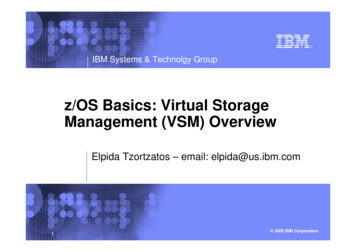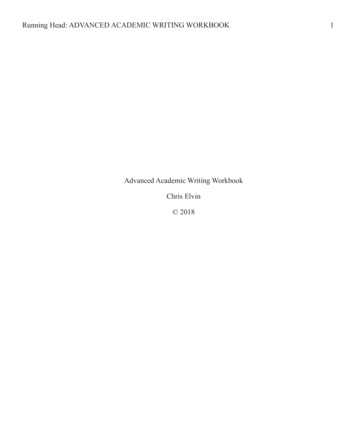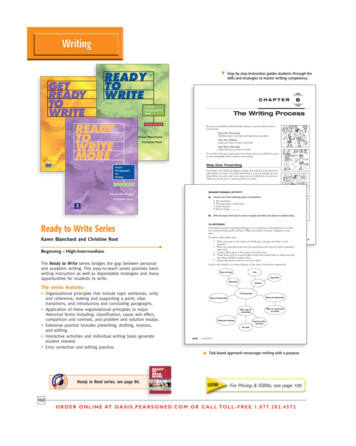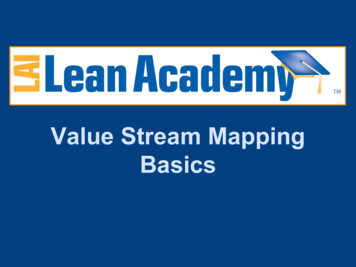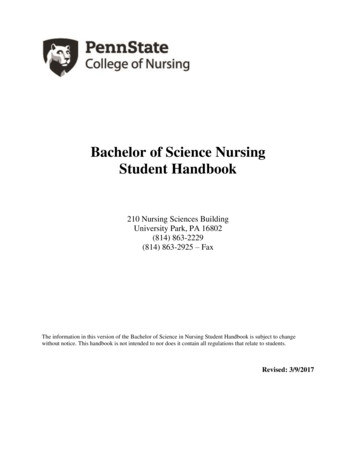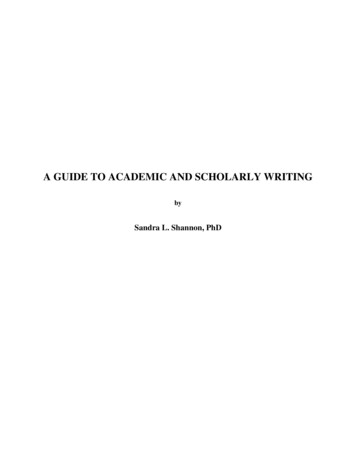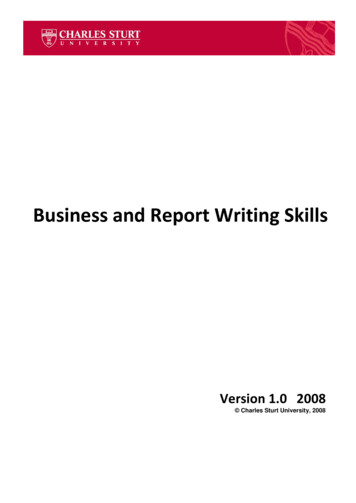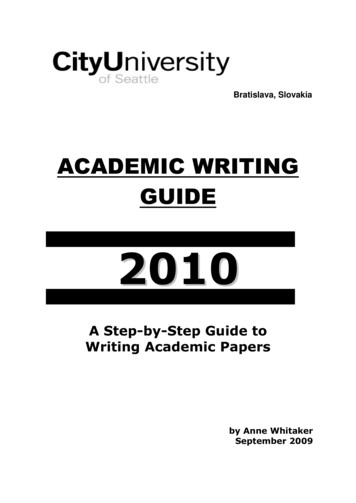
Transcription
Bratislava, SlovakiaACADEMIC WRITINGGUIDE2010A Step-by-Step Guide toWriting Academic Papersby Anne WhitakerSeptember 2009
Table of ContentsWhy Academic Writing . 2The Writing Process . 4Choosing and Narrowing a Topic . 4Thinking (Brainstorming). 6Doing Research . 6Thesis Statement . 7Planning – Basic Outline . 7Planning – Taking Notes . 9Planning – Detailed Outline. 10Writing the First Draft . 13The Introduction . 13Body Paragraphs . 14The Conclusion . 15Connection between Ideas . 16Revising . 17Editing . 18Proofreading . 19Paper Checklist . 20Example Paper . 21Bibliography . 28
Why Academic WritingAcademic writing is, essentially, the writing you have to do for your university courses.Your instructors may have different names for academic writing assignments (essay,paper, research paper, term paper, argumentative paper/essay, analysis paper/essay,informative essay, position paper), but all of these assignments have the same goal andprinciples.Goal of Academic Writing: Why do students have to write papers?The truth is that academic papers are a specially-designed torture instrument. They arepreferred because instructors are not directly involved in the torture. Usually studentstorture themselves by waiting until the last minute to write their papers and by notknowing what they are doing.That's why this guide was written. A paper is not supposed to be torture. Seriously. Thething about torture was a joke. An academic writing assignment is supposed to be youropportunity to explore something that interests you from your course. You have freedomto choose a topic, empty pages on which to express your own ideas, and an audiencethat is interested in reading what you think.In an academic writing assignment, you will start by asking a good question, then findand analyze answers to it, and choose your own best answer(s) to discuss in your paper.Your paper will share your thoughts and findings and justify your answer with logic andevidence. So the goal of academic writing is not to show off everything that you knowabout your topic, but rather to show that you understand and can think critically aboutyour topic (and this is what earns you a good grade).Plus, you will develop skills in researching, evaluating information, organizing, arguing,responding to others’ arguments, analyzing, and expressing yourself clearly in writing (inEnglish too). These skills, by the way, are all valued by employers.10 Principles of Academic WritingClear Purpose. The goal of your paper is to answer the question you posed as yourtopic. Your question gives you a purpose. The most common purposes in academicwriting are to persuade, analyze/synthesize, and inform.oPersuasive purpose – In persuasive academic writing, the purpose is to getyour readers to adopt your answer to the question. So you will choose oneanswer to your question, support your answer using reason and evidence, and tryto change the readers’ point of view about the topic. Persuasive writingassignments include argumentative and position papers.oAnalytical purpose – In analytical academic writing, the purpose is to explainand evaluate possible answers to your question, choosing the best answer(s)based on your own criteria. Analytical assignments often investigate causes,examine effects, evaluate effectiveness, assess ways to solve problems, find therelationships between various ideas, or analyze other people’s arguments. The“synthesis” part of the purpose comes in when you put together all the parts andcome up with your own answer to the question. Examples of these assignmentsinclude analysis papers and critical analyses.oInformative purpose – In informative academic writing, the purpose is toexplain possible answers to your question, giving the readers new informationabout your topic. This differs from an analytical topic in that you do not push yourviewpoint on the readers, but rather try to enlarge the readers’ view.Some assignments will have a pre-determined purpose (see the examples above);for other assignments, you will have to choose a purpose when you choose a topic2
(research paper, term paper). And some assignments may have two purposes. In allcases, the purpose will be clear at the beginning of your paper, and your paper mustachieve its purpose in order to be successful.Audience Engagement. As with all writing, academic writing is directed to a specificaudience in mind. Unless your instructor says otherwise, consider your audience tobe fellow students with the same level of knowledge as yourself. As students in thefield, they are interested in your topic, but perhaps not so interested in reading apaper. So you will have to engage them with your ideas and catch their interest withyour writing style. Imagine that they are also skeptical, so that you must use theappropriate reasoning and evidence to convince them of your ideas.Clear Point of View. Academic writing, even that with an informative purpose, isnot just a list of facts or summaries of sources. Although you will present otherpeople’s ideas and research, the goal of your paper is to show what you think aboutthese things. Your paper will have and support your own original idea about thetopic. This is called the thesis statement, and it is your answer to the question.Single Focus. Every paragraph (even every sentence) in your paper will supportyour thesis statement. There will be no unnecessary, irrelevant, unimportant, orcontradictory information (Your paper will likely include contradictory or alternativepoints of view, but you will respond to and critique them to further strengthen yourown point of view).Logical Organization. Academic writing follows a standard organizational pattern.For academic essays and papers, there is an introduction, body, and conclusion. Eachparagraph logically leads to the next one.oThe introduction catches the readers’ attention, provides backgroundinformation, and lets the reader know what to expect. It also has the thesisstatement.oThe body paragraphs support the thesis statement. Each body paragraph hasone main point to support the thesis, which is named in a topic sentence. Eachpoint is then supported in the paragraph with logical reasoning and evidence.Each sentence connects to the one before and after it. The readers do not have towork to find the connection between ideas.oThe conclusion summarizes the paper’s thesis and main points and shows thereader the significance of the paper’s findings.Strong Support. Each body paragraph will have sufficient and relevant support forthe topic sentence and thesis statement. This support will consist of facts, examples,description, personal experience, and expert opinions and quotations.Clear and Complete Explanations. This is very important! As the writer, you needto do all the work for the reader. The reader should not have to think hard tounderstand your ideas, logic, or organization. English readers expect everything to bedone for them; your thoughts and thought processes should be clearly andcompletely explained.Effective Use of Research. Your paper should refer to a variety of current, highquality, professional and academic sources. You will use your research to supportyour own ideas; therefore, it must be integrated into your writing and not presentedseparately. That means that source material will be introduced, analyzed, explained,and then cited. Research and APA Style Guide 2010 covers this topic in depth.Correct APA Style. All academic papers should follow the guidelines of the AmericanPsychological Association as found in Research and APA Style Guide 2010, regarding3
in-text citations, the reference list, and format.Writing Style. Because this is your work, you should use your own words wheneverpossible. Do not try to write like a boring, overly formal scholarly article. Use thenatural conversational style that you would use in the classroom. Your writing shouldbe clear, concise, and easy to read. It is also very important that there are nogrammar, spelling, punctuation, or vocabulary mistakes in academic writing. Errorsconvey to the reader that you do not care.And finally, this rule will override all the principles:ALWAYS FOLLOW THE DIRECTIONS OF YOUR INSTRUCTOR. Every instructorhas a reason for giving you an assignment, and each instructor's requirements maydiffer. Follow your instructor’s directions to get the most from an assignment.The Writing ProcessYou’ve just received your first academic writing assignment. What do you do? If you area beginning writer, take it step by step. The following writing process has worked formillions of university students.Choose a topic.Think (brainstorm).Research.Discover your thesis.Plan (outline).Write.Revise.Edit.Proofread.This guide will go through each of these steps with you. Beginning writers should followthis process. However, as you become more experienced, you may find that a differentorder works best for you. That is OK. You will also find that you have to do some stepsmore than once; for example, you may do research before you choose a topic, as yououtline, and as you revise. You will certainly need to revise your paper several timesbefore doing the final proofreading. And of course, you should never stop thinking.Choosing and Narrowing a TopicSometimes your instructor will give you a list of possible questions or themes, and othertimes you will have the freedom to choose your own topic. Sometimes the assignmentwill have a specific purpose (argumentative essay, analysis paper), and other times youwill have the freedom to determine the purpose (research paper, term paper). Thisfreedom can be both great and terrifying. If you have trouble choosing what to writeabout, start with a few ideas and choose the best one after several steps. You can alsoconsult with your instructor about the best topic choice.How to Choose a TopicThink about things related to the course that you are interested in. If there is nothingwhich interests you, look through the textbook, instructor-recommended resources,course slides, handouts, and current periodicals for possible ideas.4
Then you need to narrow your ideas from subjects to topics. A subject is a broadconcept: conflict management, abortion, the Cold War, capital budgeting, organizationalculture, global warming, Toyota’s management style, and EU agricultural subsidies are afew examples. These are not paper topics; these could all be the subjects of books.Narrow a subject by looking at its smaller parts, or by choosing a specific problem, timeperiod, or place to cover. You may need to do a little general research here if you do notknow much about the subject. Also asking yourself “Who? What? Where? When? Why?and How?” questions about the subject can help you limit the subject and determineyour interests.Doing this with abortion, for example, leads to topics like the reasons American womenchoose abortion rather than adoption, the psychological effects of previous abortions onwomen who become pregnant again, the consequences of Poland’s ban on abortions onPolish women’s lives, solutions to ending the practice of using abortion as a tool forgender selection in India, and whether or not the morning after pill should be sold togirls under 16. From here, choose a topic which fits the prescribed purpose of your paper(if there is one).Specific topics like these are much more likely to fit the goal of academic writing and tofit the number of pages allowed in your paper.Writing your Topic as a QuestionOnce you have a specific topic for your paper, write your topic as the question whichyour paper will answer. Doing this is a great way to focus your paper and ensure thatyou meet the paper’s purpose. In fact, your purpose will determine the type of questionthat you ask.For example, an argumentative paper would probably have a yes/no question, such as“Should the U.S. have used the atomic bomb in World War II?” or “Should the morningafter pill be sold to girls under 16?” or “Should animal organs be used for humantransplants?” or “Which is a better strategy for the EU to follow to encourage change inBurma – engagement or isolation?” And then, of course, your paper would argue foryour answer to the question.An analytical paper most likely has a why/how question, such as “Why has childhoodobesity been increasing in the United States?” or “How has Poland’s ban on abortionsaffected women’s lives?” or “How effective is the article in supporting the author’sthesis?” or “How could the EU best reform its agricultural subsidies?” And then, ofcourse, your paper will analyze the various answers, justifying your point of view to theaudience.An informative paper often has a what/why/how question, such as “What are thenegative aspects of wind energy?” or “What are the causes of anorexia in teenage boys?”or “How can managers evaluate whether to invest money in a software upgradeproject?” And then, of course, your paper will explain the various answers, giving thereaders a new way of looking at the topic.Characteristics of a Good Paper TopicYour question does not have a simple answer. A good question has severalalternative answers, or no accepted answer, or maybe an easy but unsatisfactoryanswer. In other words, there is no one “right” answer to your question. Your paperwill give and justify your own best answer(s), and it will require research and criticalthinking to do this.5
Your question is worth answering. The readers will care about the answer to yourquestion. Your answer will have some significance.Your paper will achieve its purpose. Will your informative paper truly give yourreaders a new perspective? Will your readers accept your analysis in your analyticalpaper? Will your persuasive paper succeed in changing your readers’ view?This is especially important to consider with persuasive paper topics. Avoid topics inwhich arguments are mostly based on (usually unchanging) personal beliefs, ratherthan reason and evidence. Whether abortion should be legalized is such a topic.You are interested in the topic. You will spend a lot of time with this topic, sochoose something that will not bore or torture you.The topic is the right size for the length of the paper. Make sure you will nothave too little or too much to say for the number of pages allowed.There is enough (but not too much) information available in reliablesources. If you find too much information, you will need to narrow your topicfurther; if you find too little information, you should widen your topic.You have enough time to do what you need to do. How much time do you havebefore the due date? You may have to limit the complexity of your topic if you havewaited too long to start .Thinking (Brainstorming)When you have a topic, start brainstorming. Write down all the possible answers to yourquestion, and write down all the information, opinions, and questions you have aboutyour topic. Brainstorming will help you see what you already know, what you think, whatyou think you know, and what else you need to find out about your topic. Writing thingsdown also ensures that you will not forget your great ideas later. (Although this is areally short section, it is a very important step!)Doing ResearchDoing research is covered on pp. 3-12 of the Research and APA Style Guide. Read them!What you must remember is that “doing good research takes time.” Do not expect to doresearch once and find everything that you need for your paper. Research is an on-goingpart of the writing process. You will start now, doing general research to learn moreabout your topic, but you will continue doing research throughout the writing process, asyou discover a thesis, make a basic outline and then a detailed outline, write your paper,and revise your paper. Also, do not be afraid to change your topic a little (or a lot) ifyour research leads you in a different direction.To make research more effective and less time-consuming, you can do three things:Plan your research before your start, using the research guide’s tips (pp. 3-4).Set up and follow a research schedule. Give yourself a set amount of time to doyour preliminary research. Start working on your paper, and go back to researchinglater when you know exactly what you need to find.Immediately record source information. Write down the address or bookmarkthe web page of every good source, even if you are not sure if you will use it youmay want to later.6
Thesis StatementThe thesis statement is the most important sentence in your paper. If someone askedyou, “What does your paper say?” your answer would be your thesis statement.Everything you write will support this statement.A good thesis statement usually includesMain idea of the paper. ONE idea. The entire paper is based on this statement.Your opinion or point of view. The thesis statement is not a fact nor a question,but your view of the topic and what you want to say about it.Purpose of the paper. From the thesis, it should be clear what the paper will do.Answer to the research question. Ask yourself the question and then answer itwith your thesis. Is it truly an answer? (if not, change the question or the answer!)An element of surprise. This means that the thesis is interesting, engaging, andperhaps not so expected.Clarity. It should be understandable after one reading and have no mistakes.When should you write your thesis statement? It depends on when you know the answerto your research question. You may have an idea before you begin researching, you maydiscover it as you research, or you may not know it until you have almost finishedwriting your paper. It’s useful to have a thesis idea at the beginning to help you focus,but it’s also OK to change your thesis statement as you go through the writing processand learn and think more about your topic.Planning – Basic OutlineAfter you have a preliminary thesis statement (the answer to your research question),you can make a basic outline. You may be able to do this before doing any research, oryou may need to read more about the topic first. You should, however, have a basicoutline before you finish researching in order to ensure that your paper is focused onYOUR thoughts, not just your sources’.A basic outline is your first attempt to organize the ideas of your paper. It will help youfocus your research and consider the order of your ideas. To make one:Choosing and ordering points1. Write your question and answer (preliminary thesis statement). Don’t worry aboutwriting a beautiful, memorable, strong thesis statement yet; just a simple answer toyour question is enough to start the basic outline.2. Write down all the reasons/arguments/effects/solutions (each type of paper isdifferent) you have to answer your question and support your thesis. Do not look atyour sources – use your own brain.3. Look at your list and organize the ideas. Some may be combined as one larger idea;some may just repeat others in different words. You may decide to delete some too.4. The remaining ideas will be the main points of your paper. These ideas are thesections of your paper.5. Decide how to order these points. What order will you follow – chronological, cause7
to effect, problem to solution, most important to least important, weakest tostrongest? Which order will make your paper the strongest and most interesting?6. Your paper should also cover alternative or opposing viewpoints to show that youhave done complete research and considered all ideas. In this “con section,” you willpresent and refute (argue against) other views of your topic.EXAMPLE BASIC OUTLINE before research (argumentative paper)Research Question: Are birth control pills safe for women?Thesis: Birth control pills are safe.Sections:I. Pills contain nothing harmful to health.II. Pills bring health benefits to women.III. Myths about birth control pills are wrong.EXAMPLE BASIC OUTLINE before research (analysis paper)Research Question: Why has childhood obesity increased in the United States?Thesis: Childhood obesity has increased in the United States due to the unhealthyenvironment in which many American children are raised.Sections:I. Children eat more than in the past.II. Children often do not eat healthy meals.III. Children do not have as much physical activity as in the past.IV. Parents model bad habits.V. Others say that food companies, advertising are responsible.Breaking sections into smaller parts7. Those are very basic outlines. It is possible to add more to them, especially after alittle research. For each section, think of how much support you have. If you have alot of supporting details (facts, examples, expert opinions) and explanations, then youwill need more than one paragraph for that section. Some sections, especially yourstrongest, need more than one paragraph, while others may have only one.8. Divide your sections into smaller points. Write the idea of each possible paragraph asa sentence so you can see how/whether it still answers the research question.EXAMPLE BASIC OUTLINE after more thinking and/or research (argumentative paper)Research Question: Are birth control pills safe for women?Thesis: Although there are some disadvantages, birth control pills are safe.Sections:I. Pills contain nothing harmful to health.II. Pills bring some health benefits to women.IV. Myths about birth control pills are wrong.1. They do not cause ovarian cancer, but prevent it.2. They do not cause breast cancer.3. It is safe to use them when breastfeeding if done right.IV. There are some minor disadvantages, but not for healthy women.(4 sections, with a total of 6 paragraphs)8
EXAMPLE BASIC OUTLINE after more thinking and/or research (analysis paper)Research Question: Why has childhood obesity increased in the United States?Thesis: Childhood obesity has increased in the United States due to the unhealthyenvironment in which many American children are raised.Sections:I. Children eat more than in the past (portion sizes have increased).II. Children often do not eat healthy meals.1. Healthy food is hard to get (expensive rare).2. Schools provide unhealthy foodIII. Children do not have as much physical activity as in the past.1. Physical activity in schools has decreased.2. Some children live in areas unsafe for outdoor activity.3. Many children watch too much TV.IV. Parents model bad habits.1. Parents do not have time, money, or information to prepare healthy meals.V. Food companies and advertising may bear some responsibility, but parents shouldbe able to help children resist them.(5 sections, with a total of 8 paragraphs)Planning – Taking NotesAn important part of the research and planning process is taking notes of the informationand ideas that you find. As you read a source, marking and writing down the importantthings that you read will help you to remember them and understand them better. Itmay seem time-consuming, but writing the paper will go faster if you already have allyour ideas marked and written down.Start taking notes from or on your sources during or after your research period. It’seasier to do this after you have a basic outline. Then you can organize the notes aroundthe main points of your paper. Still, you will probably have more notes than you need foryour paper because your original ideas and organization will change.Where to take notesOn photocopies or printed Internet documentsoHighlight or underline important information.oTake notes in the margin. Write down your comments/questions about theinformation. Note which main point from your paper the information supports(this will help you when you are organizing and writing your paper later).On a computer fileo Create a separate Word document for each section of your paper.oTake notes of important information from paper sources. Don’t forget to includethe author’s name.oPut text copied from web pages in quotation marks. Be very careful – this oftenleads to unintentional plagiarism. Don’t forget to include the author’s name andweb address.In a notebookoWrite the author's name at the top of the page.9
oTake notes of important information. In the margin, note which main point fromyour paper the information supports.On note cardsoWrite one piece of information on each card.oDon’t forget the author’s name and other source information.oPut the main point from your paper at the top of the card so you can organize allthe notes later.What to take notes aboutBackground information about your topic which is necessary for your paper.Arguments and explanations which support or oppose your ideas.Facts, examples, expert opinions, and other supporting details.How to take notesSummarize – Write the main points of the source in your own words. Good forsources with ideas, but not many details, related to your topic.Paraphrase – retell important information in your own words; use quotation marksfor directly copied words. Good for details which will support/oppose you.Quote – copy the exact words from the source. Good for strong, exciting passages.Comment – write any questions or ideas you think of when you are reading sources.Planning – Detailed OutlineAfter going through your sources and taking notes, you can create a detailed outline byadding details to your basic outline as well as adding any new points that you found.A detailed outline plans each body paragraph of your paper for you, from main point tosupporting points to supporting details.Many students would prefer to skip this part of the writing process and just start writingtheir papers, since it takes a lot of time, thinking, and re-thinking to develop a goodoutline. Well, if you are an advanced academic writer, go ahead. Writers with a lot ofexperience know what works best for them. However, if you are still learning how towrite academic papers, you should make a detailed outline for several reasons:You will learn whether you have enough support for your thesis statement.You will have a map to follow when writing your paper.You will avoid major organizational problems in your paper if you organize your ideasbefore you write.You will have a chance to think more about your topic, refining your ideas.Some instructors will require draft outlines before your paper is due, or even finaloutlines with your paper, so you need to know how to write outlines.After you have mastered the academic writing process, then you can decide whether orwhen to write a detailed outline. Here are the steps to follow when making your outline:1. First, make changes to your basic outline’s thesis and main points until you aresatisfied with your ideas and the order of your sections.2. Then go through your notes and find supporting points for each section of youroutline.10
3. Organize the supporting points in each section.4. Go through your notes and add supporting details (facts, examples, expert opinion,descriptions, quotes, etc.) to each point. Be thorough so that the reader of youroutline can understand how the detail supports the point.oAlways include the source of any research that you put in your outline (Author,year). If you use the source’s exact words in your outline, use quotation marks.5. Now, based on the amount of supporting points and details in each section, you candetermine how many paragraphs you will need.6. Divide your outline into paragraphs, each with a main point written in sentence form(preliminary topic sentence) and list of supporting points and details.EXAMPLE DETAILED OUTLINE - 3 paragraphs (argumentative paper)Thesis: Although there are some disadvantages, birth control pills are safe.Section/Paragraph #1 Pills contain nothing harmful to women’s health.1. Pills contain hormones produced by women’s bodies.- Combination (estrogen progestin) and progestin only (Planned Parenthood, 2003)- Estrogen – activates uterus, thickens walls. Progesterone – helps uterus accept egg(National Cancer Institute, 2003)2. Pills give women the right amount of hormones so they can’t get pregnant- Estrogen pill stops egg production, progestin pill will “thicken cervical mucus” so nofertilization (Planned Parenthood, 2003, Basics section, para. 2)- Hormones “fool the body into acting as if it’s pregnant” (Alice, 1998)Section/Paragraph #2 Taking birth control pills has benefits for women's health.1. Avoid unwanted pregnancy2. Improve skin- less acne, less “excess” hair (Greenfield, 2004a)3. Other benefits are fewer ovarian cysts, and less likelihood of anemia (Greenfield, 2004a)4.
a beginning writer, take it step by step. The following writing process has worked for millions of university students. Choose a topic. Think (brainstorm). Research. Discover your thesis. Plan (outline). Write. Revise. Edit. Proofread. This guide will go through each of these step
